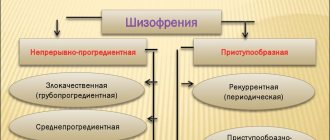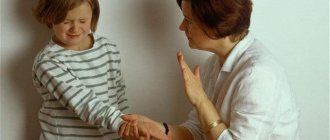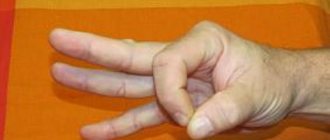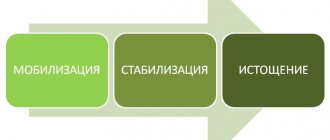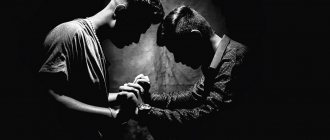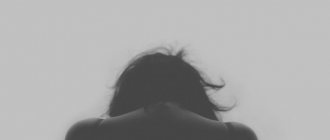Cerebral palsy (CP) is a disease caused by damage to one or more parts of the brain. The development of pathology can occur in a child during intrauterine development, at the time of birth or in newborn age.
Exercise therapy for children with cerebral palsy is one of the most effective means of rehabilitation, since the disease is characterized by impaired muscle tone. During physical therapy classes, the child learns control over movements, his range of motion and coordination improves. At the rehabilitation center of the Yusupov Hospital, experienced exercise therapy instructors select an effective set of exercises. The clinic accepts patients aged 18+.
The essence of the diagnosis of cerebral palsy
You may be interested in:Barthel Scale: description, features and application
Cerebral palsy (CP) is a chronic disease that does not belong to the group of progressive ones, but requires constant and regular treatment due to pathologies of the brain, in its cortex or subcortical areas, trunk or capsules. This disease manifests itself mainly in the partial physical and intellectual-psychological failure of a person, as well as the inability to fully control his body. This failure is explained by the fact that the patient’s brain does not send a signal to the muscles for motor activity, so he cannot control most of his movements. The reason for this diagnosis is often abnormal intrauterine development, childbirth with complications, birth hypoxia or asphyxia, as well as endocrine or infectious diseases suffered by the mother of a sick baby during pregnancy. Children with cerebral palsy later begin to hold their heads, roll over from back to stomach, sit, and walk. Many of them cannot walk when they are already growing up.
You may be interested in: How to choose a crutch: types, selection options, photos
But there is one positive moment in this whole sad story: cerebral palsy is not a death sentence. There are a lot of different methods, therapeutic measures, various medicinal methods that contribute to the partial restoration of the child’s health and bring him closer to normal functioning.
A timely visit by the parents of a child with cerebral palsy to a neurologist for consultation can contribute to their earlier intervention in the course of the disease process and the rehabilitation of the child’s deplorable state of health through the implementation of certain procedures. Medicine that does not stand still offers all kinds of ways to improve the well-being of a child with this diagnosis in the form of massages, therapeutic exercises, classes on special simulators, physiotherapy, magnetic therapy, electroreflexotherapy, Bobath therapy, the Voight method, classes with speech therapists and psychologists, and the use of auxiliary equipment. And not the last place in this chain is occupied by therapeutic physical education (PT) for cerebral palsy.
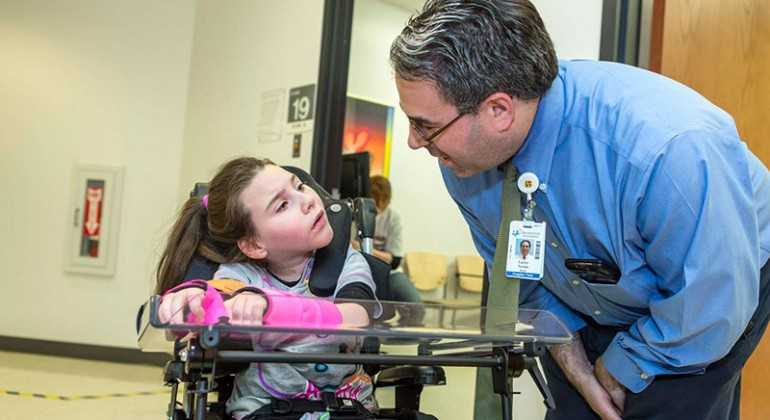
Directions of exercise therapy for cerebral palsy
Before moving on to exercises, it is important for parents to understand that physical therapy has several independent directions. However, they do not always relate to gymnastics. Other therapeutic forms are also used that are aimed at improving the child’s well-being.

The following groups of exercises are distinguished:
- support and improvement of motor function.
- strengthening joints.
- improving facial expressions and control over emotions.
- breathing correction.
- abdominal muscles.
- torso and neck area.
The treatment complex itself may consist of the following aspects. Stretching for the child, walking and body control may be used. By the way, quite often doctors recommend performing yoga, naturally, focusing on the patient’s well-being.
Healing Fitness
It's no secret that sport is the key to a healthy body and a healthy mind. Sports activities give a person the opportunity to actively spend time in motion, develop all muscle groups, receive a charge of energy and vigor, give his body aesthetically beautiful curves and shapes, and maintain himself in an excellent mood and high spirits. You can endlessly list the benefits of playing sports, as well as name all kinds of sports activities. But a special place in this list should be given to physical therapy.
You may be interested in: How to choose crutches: types, selection options, photos
Exercise therapy is a set of special therapeutic techniques using physical exercises that help improve the condition and partially restore the health of sick and disabled people, and are also used as a preventive measure against possible diseases. Physical therapy itself is considered a medical discipline with pedagogical features, since it is not only the performance of isolated physical exercises, but also the instilling in the patient of self-confidence and confidence that success will come and health will return. It is not surprising that a set of exercise therapy exercises for cerebral palsy is used as one of the methods of rehabilitation in the case of children with cerebral palsy. After all, the parents of an unfortunate child are ready to do any exercises, follow all possible gymnastic complexes and undergo all kinds of therapies just so that their child at least partially feels the joy of a full life.
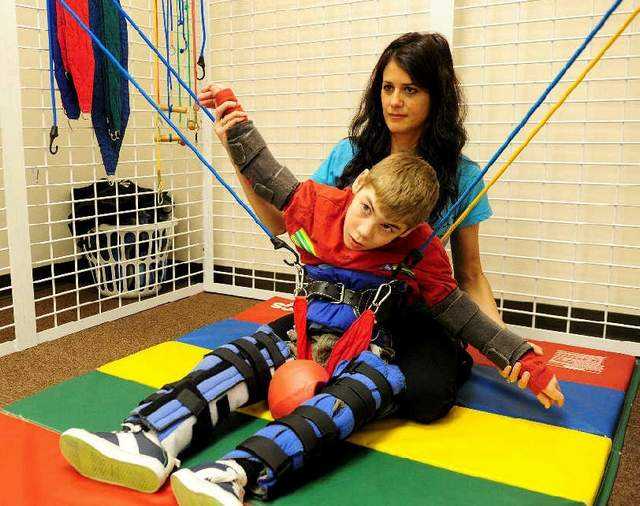
The importance of therapeutic exercises for cerebral palsy
What is the peculiarity of the influence of exercise therapy exercises for cerebral palsy? What causes remission of individual muscle groups in the body of a child affected by cerebral palsy? And how does the exercise therapy complex work for cerebral palsy? To answer these questions, you need to understand what the goals, objectives and principles of the method of physical therapy are, which helps to rehabilitate the health lost by the baby during the prenatal, birth or postpartum period.
The main goal of exercise therapy for cerebral palsy in children is to develop the ability to voluntarily inhibit movements, as well as reduce muscle hypertonicity, improve motor coordination, and increase amplitude movements in the joints. For children whose muscle activity is inhibited and does not allow them to function normally physically, this is a very important aspect of rehabilitation.
The objectives of the exercise therapy complex for cerebral palsy include several main areas:
- implementation of general strengthening and health effects on the body;
- assistance in restoring the body's performance;
- normalization of blood circulation and metabolism in the affected area;
- complete or partial regulation of metabolic and neurovascular disorders;
- preventing the appearance of adhesions in the area between nearby tissues and nerve sheaths;
- replacement of already formed adhesions by the adaptation of tissues to such formations through special exercises;
- strengthening weak muscle tissue;
- development of movement coordination;
- assistance in the fight against associated anomalies - curvature of the spine, impaired mobility, and so on.
And this list is not final. Methods of exercise therapy for cerebral palsy include building a set of exercises on the principles of regularity, systematicity, continuity of classes, an individual approach to each patient, paying attention to his age and mental development, taking into account the severity and stage of the disease. All these aspects together predetermine a positive result from the procedures, which determines the importance of this kind of physical therapy for children with disorders of the nervous and mental systems.

Respiratory therapy for cerebral palsy
With cerebral palsy, against the background of impaired motor function, respiratory function is also impaired, which leads to a decrease in the supply of oxygen to tissues, especially nerve and muscle fibers. Practice shows that the use of breathing exercises contributes not only to the treatment of the underlying disease, but also concomitant ones (acute respiratory infections, asthma, allergies, chronic bronchitis, etc.).
You can use Strelnikova’s breathing exercises, Buteyko’s method of volitional regulation of the depth of breathing, breathing exercises of Qigong and yogis.
You can do breathing exercises with your child starting from 2 years old, changing various sets of exercises with age. It is important to remember their main feature: the therapeutic effect is possible only after several months of daily exercise.
Lecture No. 3.
Types of exercises
What are the main variations of exercise therapy for cerebral palsy that the rehabilitation course for patients is based on?
- Fixed position is a model of therapeutic exercise based on fixing the limbs in a special splint or splint.
- Muscle stretching - involves swaying in all joints of the limbs with an amplitude of oscillations designed to gradually increase.
- Muscle relaxation - involves alternating fixation of arms and legs to reduce the number of involuntary movements carried out by a sick child, as well as to reduce increased tone.
- Walking provides an opportunity to develop the motor system for higher mobility capabilities.
- Exercises with stimulation of muscle activity and muscle inhibition are alternate flexion-extension of joints with parallel muscle massage.
- Climbing on a surface with an incline is carried out with an instructor and gives the opportunity to train, as far as possible, the abs and leg muscles, maintain balance and maintain balance.
- Exercises to develop endurance.
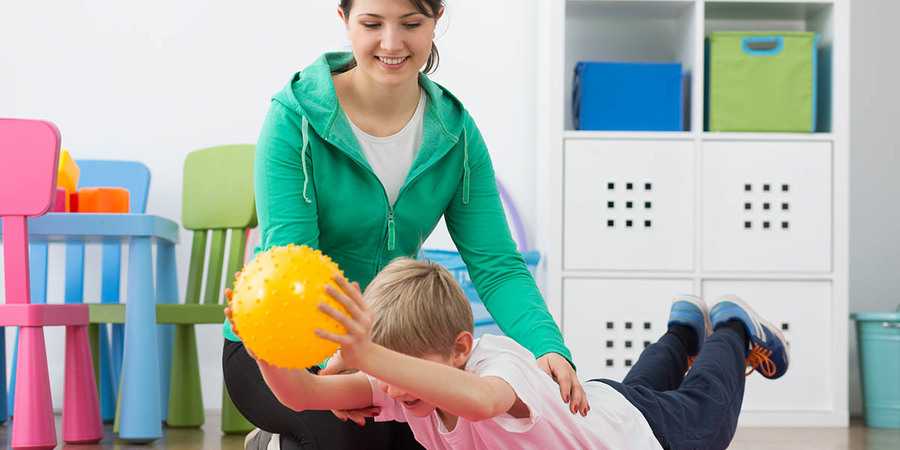
Exercise therapy to activate the musculoskeletal system
The complex of exercise therapy exercises for children with cerebral palsy provides priority exercises for the most important area of rehabilitation – the motor system. After all, many children with cerebral palsy are not able to walk, they need help, they need to be taught this. In cases where the central or peripheral nervous system is damaged, problems with movement of the upper or lower limbs may occur. This problem is referred to in medicine as tetraparesis. In order to strengthen the motor and coordination skills of disabled children, as well as increase their degree of control over their own actions, appropriate gymnastic exercises are provided.
Such exercise therapy exercises for children with cerebral palsy can increase the child’s motor activity and give him a chance to learn to walk.
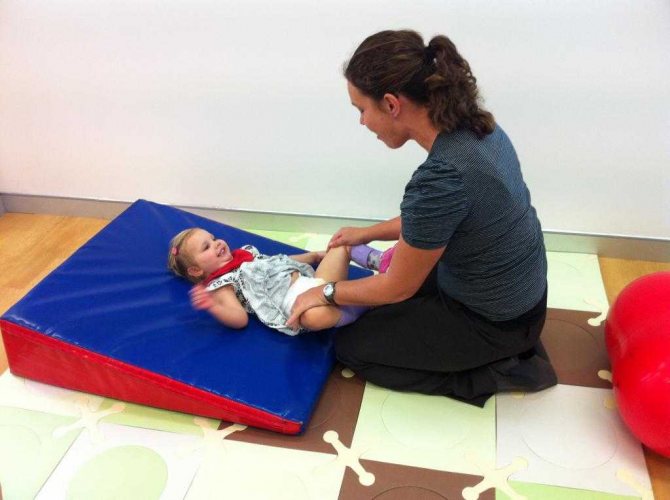
How does massage work as a therapeutic method?
Also, complex exercise therapy for children with cerebral palsy includes massage procedures. They effectively help patients relax, improve blood circulation, normalize metabolic processes and relieve spasms. To improve the condition of the musculoskeletal system, you need to use several types of massage:
- point;
- segmental;
- classical.
After the first acquaintance with massage techniques, parents can do it to the baby themselves at home. These procedures are taught in specialized courses.
Another set of exercise therapy exercises for children with cerebral palsy has also recently been developed. These procedures include:
- Continuous stroking of the limbs quickly relaxes the muscles.
- Felting has a beneficial effect on large areas of the body.
- Skating is good for the shoulder and hip joints.
- Light tapping promotes rapid muscle relaxation.
- Rubbing the body with the palm of your hand, this procedure perfectly stimulates the muscles of the back, hips and buttocks.
- The strokes are intermittent and keep all muscles well toned.
Important point! All exercises and massages should be dosed; their duration should be increased gradually as the patient’s condition improves.
Exercise therapy for working out joints
It is equally important to teach the child to control his movements and strengthen his joints. The peculiarity of this moment is that children with cerebral palsy are characterized by pain in the joints, convulsive pain and related pathologies. In order to develop the joints of the limbs, you need to pay attention to a number of exercise therapy classes aimed at strengthening them in case of cerebral palsy.
- The starting position of the child is lying on his back. One leg is extended and fixed by an adult under the body’s own weight or under the support of a hand, and the second is gradually bent at the knee. At the same time, the thigh is pressed against the stomach if possible, after which it is smoothly moved back to its original position.
- The starting position of the baby is lying on its side. The knee is kept bent, the thigh alternately abducts and then returns to its original position.
- The primary position of the body is standing facing the table close to it. It is necessary to lean your stomach against it so that your legs hang freely, and then alternately straighten them, straightening your knees, then return them to a suspended state.
- Lying on his back, the child, with the help of an adult, bends his leg at the knee, after which, if possible, straightens it as straight as possible.
- Having placed a child with cerebral palsy on his stomach, an adult or instructor places a cushion under his chest, after which, holding the baby by the hands, he lifts the upper part of his body, making jerky and springy movements up and down.
- The starting position of the baby is lying on his back. The arms are bent at the elbow so that the face remains motionless and turned to the side. After which the adult helps the child bend the limb, turning his head in a different direction.
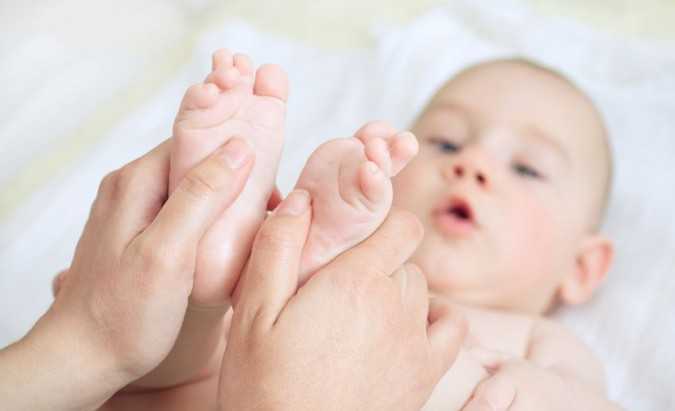
Exercise therapy for stretching
A set of stretching exercises for children with cerebral palsy also helps to increase flexibility. It allows you to reduce the severity of the pathological condition of the back and spine, improves the condition of the affected spinal cord, as well as its nerve endings. Moreover, this kind of exercise therapy for children with cerebral palsy allows them to strengthen the muscles of the limbs, which, of course, affects more confident movements of the arms and legs.
- The child must be seated in the starting position on the floor so that the legs are straightened, and the torso along with them creates a right angle and is perpendicular to the floor. While exhaling, the baby should try to bend down so that he can reach his toes with his fingers. At the same time, the help of a physical therapy instructor for children with cerebral palsy in this exercise is that he helps to lower the body even lower, applying gentle pressure on the back so that the child’s forehead also touches the legs.
- While lying on his stomach, the child extends his arms along his body. Then he turns his hands towards the floor and focuses on them. Gradually resting on his hands and raising his chest above the floor, the baby trains stretching of the biceps muscles, imitating push-ups of a healthy person. An adult must ensure that the child does not throw back his head and that his breathing is calm and even.
- The next exercise is reminiscent of a lower abdominal press with legs thrown back in the complex of exercises for a healthy person. Starting position – a child with cerebral palsy lies on his back, arms extended along the body. On the count of “one”, he slowly and smoothly raises his straight legs above his head and lifts them up behind his head, touching his toes to the floor above the top of his head and without bending them at the knees; on the count of “two” he returns them just as slowly to their original position. Throughout the entire exercise, an adult controls the process and makes sure that the hands do not leave the floor.
- Starting position – sitting on the floor with your legs apart. The first movement is to bend the right leg so that its heel touches the inner thigh of the left leg, the second movement is to bring the foot of the left leg closer to the knee joint of the right leg. After these manipulations, the right hand is moved to the left knee in a girth while supporting the left leg, and the movement of the left hand moves it to the opposite side of the waist behind the back. The adult turns the child's head to the left and tilts it so that the chin touches the left shoulder. In this case, the right knee remains constantly pressed to the floor.
This set of exercise therapy exercises for children with cerebral palsy, when performed regularly day after day, contributes to a significant improvement in the condition of the little patient. Such therapeutic gymnastics is especially effective when it is carried out at an early stage of the child’s growing up. And the sooner, the better.
Swimming pool for children with cerebral palsy
Water for children has always been a source of joy, fun, and carefree. Children with cerebral palsy are, of course, no exception.
Water treatments last no more than half an hour. You should not overwork your muscles. It is better to conduct classes regularly, patiently achieving results, than at one time, which will not bring success. Exercises must be performed gradually, in complexes:
- The first 2-3 classes are conducted on land by the pool, without contact with water. It is necessary to explain to the child how to move correctly in the water. It is necessary, through gymnastics, to teach the patient to move his arms and legs correctly.
- When going into the water for the first time, you should be alert. Children with cerebral palsy are easily frightened and may not understand contact with water. The child will need additional support, both physical and moral. However, it should be noted that children get used to swimming very quickly.
- Next, attention is paid to warming up the arms. Movements of the upper limbs during swimming help strengthen the cervical vertebrae. It is necessary to show the child how to move his hands correctly. The first swings must be smooth and slow. The muscles will have to get used to the changes. In the next lessons, they begin to accelerate the rotation.
- Later, credit is given to the movement of the legs. Due to the incorrect development of the musculoskeletal system in children with cerebral palsy, it is necessary to correct this in the pool. A good way is to jump in water. To perform them, it is recommended to hold the baby’s hands.
At the moment, the field of health improvement and prevention for children with cerebral palsy of different ages is widely developing. The programs successfully help to function normally in society and everyday life. The main thing is not to rush into treatment, follow all the doctor’s instructions and be patient.
Top ↑
Exercise therapy for relaxation
It is noteworthy that exercise therapy classes for cerebral palsy in adults, just like in children, contribute to the rehabilitation process. But in adults this happens much more slowly than in children, since the children's body is much more malleable. Therefore, it is impossible to delay with exercise therapy for cerebral palsy in children.
Based on the fact that a common symptom of cerebral palsy is severe muscle hypertonicity, medicine provides special exercises to relax them.
- In order for the sick child’s arms and legs to rest, he needs to lie on his back on the floor, after which the limbs on one side are fixed in a motionless state, using weights that can be made from sandbags.
- The child should bend the free arm on the other side of the body at the elbow, while the adult conducting the therapeutic exercises helps him hold it with his forearm. The hand remains in this position until a decrease in muscle tone is felt. After which the adult helps the child shake the hand, periodically bending it, rotating it and moving it from side to side.
- The same thing needs to be done with the leg. While the fixed limbs of one side touch the child’s stomach, the adult helps him hold his shins and abduct his legs at the hip joint so as to be able to make circular movements to stretch the leg muscles. Accordingly, the legs alternate.
Exercise therapy for breathing
The system of exercise therapy for cerebral palsy provides for a remission process only with regular implementation. The training program schedule should include leisure activities for the patient every day, day after day. Only regular gymnastics and constant exercise can return the physiology of a sick child to a more or less acceptable form. Therefore, the daily frequency of complex therapy for cerebral palsy cannot be neglected.
Among other things, exercise therapy for cerebral palsy also includes the ability to breathe correctly.
- The adult shows the child how to take the correct deep breath and exhale through both the mouth and nose. To do this, you can use auxiliary equipment in the form of balls, rubber toys, soap bubbles.
- The instructor pronounces vowel sounds, then lowering and then increasing the volume of his voice. The child must repeat after him. You can alternate this exercise with singing or playing the wind instruments.
- A standard exercise to restore the breathing process is to raise your arms above your head and fill your lungs with air while inhaling deeply, as well as lowering your arms as you exhale. You can complicate the exercise by using part of the exhalation while immersing the patient's head in water.
Many schemes for working in exercise therapy for people with cerebral palsy were developed by health workers from various institutions of the relevant nature throughout the Russian Federation. One of these can be considered the Samara Children's Rehabilitation Center. Here we receive children suffering from various diseases, including cerebral palsy. Thus, a physical therapy coach and a child with cerebral palsy in Samara can easily find a common language by spending time together in one of two swimming pools, undergoing therapeutic massage, physical therapy, hydromassage, herbal aromatherapy, and educational water games.

Exercise therapy in game exercises
As mentioned earlier, the training program for children with cerebral palsy should include an adult working with the child every day, seven days a week. But in addition to this, it is necessary to take into account the rationality of the applied loads, because the child must also rest. The calculation of the loads taken as a basis in the exercise therapy complex for children with cerebral palsy should be based on the age factor, body weight and height of the sick child. In addition, you need to take into account the degree of the affected psyche and physiology, because cerebral palsy itself includes a huge number of varieties with varying degrees of severity. The more advanced the case, the more frequent and aggressive the training should be, but it should be performed with extreme care and only with a medical representative. At the same time, some children are suitable for massage in exercise therapy for cerebral palsy, and for others, water procedures - everything here is very individual, depending on the specific case of the disease.
Many children like the game-based method of working with instructors. Game exercises in exercise therapy for cerebral palsy provide not only for the effectiveness and efficiency of the process, but also allow you to interest the child and give him the opportunity to relax. In this case, specific auxiliary equipment can be used in the form of devices supporting the patient on his feet, all kinds of fitballs, soft modules, pillows and other equipment. What games can be included here?
- “Tower Destruction” - the game involves piling up soft play equipment and circles one on top of another in an imitation of building a tower structure. At the same time, an adult can help a child build such a building, but he must destroy it himself - this is the main goal of the game, to learn to make efforts to break through the “cushion” defense of the illusory tower.
- “Getting out of the rubble” - such a play exercise also involves the child using effort, only now not in a running “attack on the tower”, but in a lying position with rubble from pillows. The child’s goal is to get out of the simulated rubble.
- “Folding Knife” is a great game for stretching and flexibility of a child with cerebral palsy. Its essence lies in the fact that the child plays the role of a folded knife when he takes the position of an “embryo” on the floor and clasps his legs bent at the knees with his hands. On the count of “one” the knife opens - the child stretches his legs and arms as far apart as possible and remains there lying on his side until on the count of “two” it is necessary to return to the starting position. The exercise is performed at a moderate pace.
- “Sausage” is a humorous game with the initial position of lying on your back on the floor. An adult, represented by a parent or instructor, takes the baby by the ankles, carefully turning his legs, like levers, now in one direction, now in the other. At the same time, the pace gradually increases.
Many different game procedures and exercises in physical therapy can be cited as examples - they are all aimed at only one result. This result is a partial recovery of the baby. Partially because the damage to human health from cerebral palsy occurs not only in terms of physical impairments, but also psychological ones. And it is, alas, impossible to influence human psychology through therapeutic exercises to the extent required by the body.
Source
The role of classes
Exercise therapy for children with cerebral palsy plays an important role:
- Providing a healing effect on the general condition of the body;
- Promoting the strengthening of tissues and organs in the child’s body;
- Activation of weakened muscles;
- Combating curvature of the spinal column;
- Improving metabolism and other metabolic processes;
- Activation of brain function, acceleration of blood circulation.
Therapeutic exercise is a separate component of an integral complex that can cope with the disease.
What classes does it include?
All exercise therapy complexes for children with cerebral palsy are selected individually, but in any case it will include the following exercises:
- For relaxation;
- To improve dynamics;
- To stimulate action;
- Exercises in a lying position, sitting;
- Game-type activities, etc.
